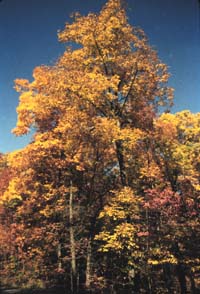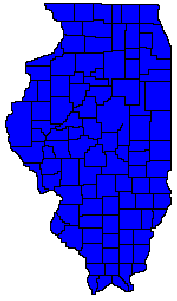 |
| Shagbark
Hickory (Carya ovata)
Distribution
Map to Right |

Shagbark hickory is a medium to large tree from 60 to 90 feet tall, with a rounded crown. The trunk is typically 2 to 3 feet (occasionally 4 feet) in diameter. The tree is most easily recognized by its bark, which is light gray, fissured, and peels off in long, curling strips when the trunk reaches 4 to 8 inches in diameter, giving the tree a "shaggy" appearance. Shagbark hickory grows in a wide range of habitats, from dry woods to low, shaded woods. It occurs in every county in Illinois.
Interesting
Facts
In addition to the "shaggy" bark, shagbark hickory is distinguishable from the other hickories by its dark reddish brown twigs that have orange lenticels (small superficial holes through which gasses are exchanged).
Identifying Features
Bark
The bark is light gray, shaggy, as the name implies, and curls off in strips.
Buds
Winter buds are large (up to one inch long) and hairy.
Leaves
The leaves are 8-16 inches long, alternate, and pinnately compound with 5 to 7 leaflets. The leaflets are elliptic to oblong-lance shaped and are up to 10 inches long. They have finely-toothed edges and pointed tips, tapering toward the base of the leaflet. The tips of the teeth each have a fine tuft of hair. Leaflets are green and smooth on the upper surface and paler and smooth or slightly hairy on the underside.
Flowers
Male and female flowers are borne separately but on the same tree as catkins. Catkins are spike-shaped flowers, usually drooping, that bear only male or female parts and eventually fall entire from the tree. Shagbark hickory flowers appear after leaf out, and typically occur in groups of 3-5 catkins.
Fruits
Hickory nuts are up to 2 inches across, with a thick yellowish green to brownish/bronze husk that is split into 4 quarters by fissures that run all the way to the rounded base. The nut meat is light brown, sweet and, like the pecan (Carya illinoienis) edible and of considerable commercial value. The nuts are high in fat and protein content, and are an important food source for wildlife, such as squirrels, opossums, wild turkey, and ducks.
Uses
Tool
handles and athletic goods are made of hickory wood because it is strong
and has a high shock resistance. It is light brown, flexible, and very
hard. It is also used for interior finishing and fuel. Native Americans
used Shagbark hickory as a treatment for rheumatism and other ills. Shagbark,
bitternut and pignut hickory are grown extensively in Central Europe for
timber.